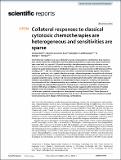| dc.contributor.author | Dalin, Simona | |
| dc.contributor.author | Grauman-Boss, Beatrice | |
| dc.contributor.author | Lauffenburger, Douglas A | |
| dc.contributor.author | Hemann, Michael T | |
| dc.date.accessioned | 2022-12-08T19:42:10Z | |
| dc.date.available | 2022-12-08T19:42:10Z | |
| dc.date.issued | 2022 | |
| dc.identifier.uri | https://hdl.handle.net/1721.1/146809 | |
| dc.description.abstract | <jats:title>Abstract</jats:title><jats:p>Chemotherapy resistance is a major obstacle to curing cancer patients. Combination drug regimens have shown promise as a method to overcome resistance; however, to date only some cancers have been cured with this method. Collateral sensitivity—the phenomenon whereby resistance to one drug is co-occurrent with sensitivity to a second drug—has been gaining traction as a promising new concept to guide rational design of combination regimens. Here we evolved over 100 subclones of the Eµ-Myc; p19<jats:sup>ARF−/−</jats:sup> cell line to be resistant to one of four classical chemotherapy agents: doxorubicin, vincristine, paclitaxel, and cisplatin. We then surveyed collateral responses to acquisition of resistance to these agents. Although numerous collateral sensitivities have been documented for antibiotics and targeted cancer therapies, we observed only one collateral sensitivity: half of cell lines that acquired resistance to paclitaxel also acquired a collateral sensitivity to verapamil. However, we found that the mechanism of this collateral sensitivity was unrelated to the mechanism of paclitaxel resistance. Interestingly, we observed heterogeneity in the phenotypic response to acquisition of resistance to most of the drugs we tested, most notably for paclitaxel, suggesting the existence of multiple different states of resistance. Surprisingly, this phenotypic heterogeneity in paclitaxel resistant cell lines was unrelated to transcriptomic heterogeneity among those cell lines. These features of phenotypic and transcriptomic heterogeneity must be taken into account in future studies of treated tumor subclones and in design of chemotherapy combinations.</jats:p> | en_US |
| dc.language.iso | en | |
| dc.publisher | Springer Science and Business Media LLC | en_US |
| dc.relation.isversionof | 10.1038/S41598-022-09319-1 | en_US |
| dc.rights | Creative Commons Attribution 4.0 International license | en_US |
| dc.rights.uri | https://creativecommons.org/licenses/by/4.0/ | en_US |
| dc.source | Scientific Reports | en_US |
| dc.title | Collateral responses to classical cytotoxic chemotherapies are heterogeneous and sensitivities are sparse | en_US |
| dc.type | Article | en_US |
| dc.identifier.citation | Dalin, Simona, Grauman-Boss, Beatrice, Lauffenburger, Douglas A and Hemann, Michael T. 2022. "Collateral responses to classical cytotoxic chemotherapies are heterogeneous and sensitivities are sparse." Scientific Reports, 12 (1). | |
| dc.contributor.department | Massachusetts Institute of Technology. Department of Biology | en_US |
| dc.relation.journal | Scientific Reports | en_US |
| dc.eprint.version | Final published version | en_US |
| dc.type.uri | http://purl.org/eprint/type/JournalArticle | en_US |
| eprint.status | http://purl.org/eprint/status/PeerReviewed | en_US |
| dc.date.updated | 2022-12-08T18:30:09Z | |
| dspace.orderedauthors | Dalin, S; Grauman-Boss, B; Lauffenburger, DA; Hemann, MT | en_US |
| dspace.date.submission | 2022-12-08T18:30:14Z | |
| mit.journal.volume | 12 | en_US |
| mit.journal.issue | 1 | en_US |
| mit.license | PUBLISHER_CC | |
| mit.metadata.status | Authority Work and Publication Information Needed | en_US |
